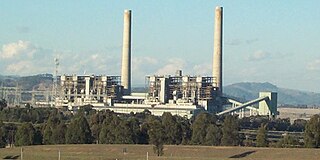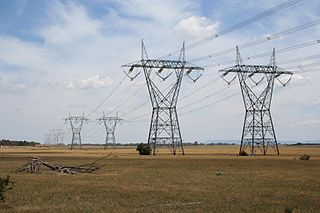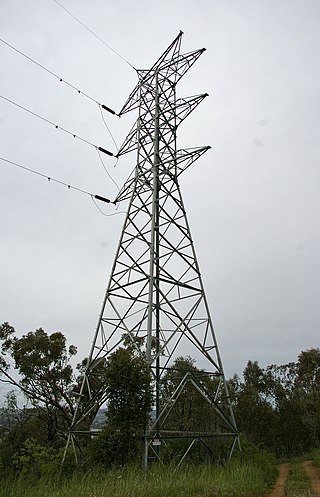Snowy Hydro Limited is an electricity generation and retailing company in Australia that owns, manages, and maintains the Snowy Mountains Hydro-electric Scheme that consists of nine hydro-electric power stations and sixteen large dams connected by 145 kilometres (90 mi) of tunnels and 80 kilometres (50 mi) of aqueducts located mainly in the Kosciuszko National Park. Snowy Hydro also owns and operates two gas-fired power stations in Victoria and one in New South Wales, three diesel power stations in South Australia and owns two electricity retailing businesses, Red Energy and Lumo Energy.

ActewAGL is an Australian multi-utility joint venture company provides utility services in the Australian Capital Territory (ACT) and south-east New South Wales. The company was formed in October 2000 between the Australian Gas Light Company and ACTEW Corporation.

Eraring Power Station is a coal-fired power station consisting of four 720 MW Toshiba steam-driven turbo-alternators for a combined capacity of 2,880 MW. The station is located near the township of Dora Creek, on the western shore of Lake Macquarie, New South Wales, Australia and is owned and operated by Origin Energy. It is Australia's largest power station. The plant has two smokestacks rising 200 m (656 ft) in height. It is slated for closure by mid-2025, after a failed attempt to sell the loss making power station back to the state government.

Vales Point Power Station is one of two operating coal fired power stations on the shores of Lake Macquarie, New South Wales. Vales Point is located on the southern shore of the lake, near the township of Mannering Park. It has two steam turbines, with a total generating capacity of 1,320 MW (1,770,000 hp) of electricity.

Liddell Power Station is a decommissioned coal-fired thermal power station that had four 500 megawatts (670,000 hp) EE steam-driven turbine alternators, providing a combined electrical capacity of 2,000 megawatts (2,700,000 hp).

Bayswater Power Station is a bituminous (black) coal-powered thermal power station with four 660 megawatts (890,000 hp) Tokyo Shibaura Electric (Japan) steam driven turbo alternators for a combined capacity of 2,640 megawatts (3,540,000 hp). Commissioned between 1985 and 1986, the station is located 16 kilometres (10 mi) from Muswellbrook, and 28 km (17 mi) from Singleton in the Hunter Region of New South Wales, Australia.

Integral Energy was the second largest state-owned energy corporation in New South Wales, incorporated under the Energy Services Corporations Act 1995 from a merger between Prospect Electricity and Illawarra Electricity. Integral Energy was involved in electricity retail in addition to owning an electricity distribution network and previously held licences to retail electricity in the contestable markets covered by the NEM.
Eraring Energy was an electricity generation company in Australia that was owned by the Government of New South Wales, and had a portfolio of generating sites using thermal coal, wind, and hydroelectric power. It was sold to Origin Energy in 2013.

Delta Electricity is an electricity generation company in Australia. The company was formed by the Government of New South Wales in 1996 as part of its reform of the electricity sector in the State, which saw the breakup of the Electricity Commission of New South Wales. Delta Electricity, which at the time owned only the Vales Point Power Station, was sold to Sunset Power International for $1 million in November 2015 and was valued at $730 million 2 years later. It has a portfolio of generating sites mainly using thermal coal power.

AGL Energy Ltd is an Australian listed public company involved in both the generation and retailing of electricity and gas for residential and commercial use. AGL is Australia's largest electricity generator, and the nation's largest carbon emitter. In 2022, 83% of its energy came from burning coal. It produces more emissions as a single company than the nations of New Zealand, Portugal or Sweden, according to its largest shareholder, Mike Cannon-Brookes, who named it "one of the most toxic companies on the planet".

Solar power is a major contributor to electricity supply in Australia. As of December 2023, Australia's over 3.69 million solar PV installations had a combined capacity of 34.2 GW photovoltaic (PV) solar power. In 2019, 59 solar PV projects with a combined capacity of 2,881 MW were either under construction, constructed or due to start construction having reached financial closure. Solar accounted for 12.4% of Australia's total electrical energy production in 2021.

Renewable energy in Australia is mainly based on biomass, solar, wind, and hydro generation. Over a third of electricity is generated from renewables, and is increasing, with a target to phase out coal power before 2040. Wind energy and rooftop solar have particularly grown since 2010. The growth has been stimulated by government energy policy in order to limit the rate of climate change in Australia that has been brought about by the use of fossil fuels. Pros and cons of various types of renewable energy are being investigated, and more recently there have been trials of green hydrogen and wave power.

Energy in Victoria, Australia is generated using a number of fuels or technologies, including coal, natural gas and renewable energy sources. Brown coal, historically, was the main primary energy source for the generation of electricity in the state, accounting for about 85% of electricity generation in 2008. The amount of coal-fired power has decreased significantly with the closure in 2017 of the Hazelwood power station which supplied around 20% of Victoria's electricity, and to a lesser extent with the exit of Anglesea power station in 2015. Brown coal is one of the largest contributors to Australia's total domestic greenhouse gas emissions and a source of controversy for the country. Australia is one of the highest polluters of greenhouse gas per capita in the world.

The Electricity Commission of New South Wales, sometimes called Elcom, was a statutory authority responsible for electricity generation and its bulk transmission throughout New South Wales, Australia. The commission was established on 22 May 1950 by the Electricity Commission Act 1950 to take control of power generation in the State. The commission acquired the power stations and main transmission lines of the four major supply authorities: Southern Electricity Supply, Sydney County Council, the Department of Railways and the Electric Light and Power Supply Corporation Ltd, also known as the Balmain Electric Light Company, the owner and operator of Balmain Power Station. The commission was responsible for the centralised co-ordination of electricity generation and transmission in the State, and some local councils continued to be distributors of electricity only.
The Australian Energy Market Operator (AEMO) performs an array of gas and electricity market, operational, development and planning functions. It manages the National Electricity Market (NEM), the Wholesale Electricity Market (WA) (WEM) and the Victorian gas transmission network. AEMO also facilitates electricity and gas full retail contestability, overseeing these retail markets in eastern and southern Australia. It is additionally responsible for national transmission planning for electricity and the establishment of a Short Term Trading Market (STTM) for gas.
South Australia is a leader in utility-scale renewable energy generation, and also produces gas and uranium for electricity generation. Gas production is mostly concentrated in the Cooper Basin in the state's north-east. Gas is delivered from these fields by pipeline to users interstate and to Port Adelaide where it fuels three separate gas-fired power plants. Uranium is also mined in South Australia, though nuclear power generation is prohibited nationally. The Olympic Dam mine is the world's single largest known deposit of uranium and represents 30% of the world's total uranium resource. Many utility-scale wind farms and solar farms have been commissioned during the 21st century and geology with potential for geothermal energy has also been identified but is yet to be developed.

Energy produced in the Australian Capital Territory mainly consists of solar electricity. Electricity consumed in the Australian Capital Territory mainly comes from the national power grid through substations at Holt and Fyshwick. The ACT currently mandates that 100 percent of its electricity, will be supplied from renewable sources by 2020. The ACT has five solar farms capable of generating about 56.3 megawatts. From 1913 until the mid 1950s some power was produced from the Kingston Powerhouse, a thermal power station in Kingston.
The Sunraysia Solar Farm is a solar farm under construction south of Balranald in south western New South Wales, Australia. It is expected to be completed around the end of 2019.












